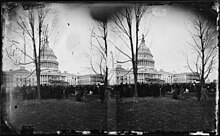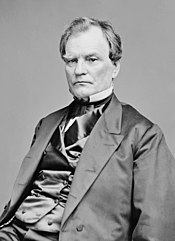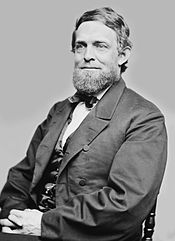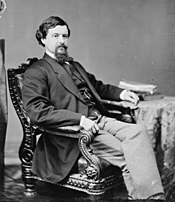| 40th United States Congress | |
|---|---|
39th ← →
41st | |

United States Capitol (1877) | |
March 4, 1867 – March 4, 1869 | |
| Members | 68 senators 226 representatives 8 non-voting delegates |
| Senate majority | Republican |
| Senate President | Vacant [a] |
| House majority | Republican |
| House Speaker |
Schuyler Colfax (R) Theodore M. Pomeroy (R) |
| Sessions | |
| Special: April 1, 1867 – April 20, 1867 1st: March 4, 1867 – December 1, 1867 2nd: December 2, 1867 – November 10, 1868 3rd: December 7, 1868 – March 4, 1869 | |
The 40th United States Congress was a meeting of the legislative branch of the United States federal government, consisting of the United States Senate and the United States House of Representatives. It met in Washington, D.C. from March 4, 1867, to March 4, 1869, during the third and fourth years of Andrew Johnson's presidency. The apportionment of seats in the House of Representatives was based on the 1860 United States census. Both chambers had a Republican majority. In the Senate, the Republicans had the largest majority a party has ever held.
Major events
- March 30, 1867: Alaska Purchase
- February 24, 1868: Impeachment of Andrew Johnson
- May 16, 1868: President Johnson acquitted
- May 26, 1868: President Johnson acquitted again
- November 3, 1868: 1868 presidential election: Ulysses S. Grant (R) defeated Horatio Seymour (D)
- December 25, 1868: President Johnson granted unconditional pardons to all Civil War rebels
- January 20, 1869: Elizabeth Cady Stanton was the first woman to testify before Congress
Major legislation
- Three Military Reconstruction Acts, continued:
- July 27, 1868: Expatriation Act of 1868, ch. 249, 15 Stat. 223
Constitutional amendments
- July 10, 1868: Fourteenth Amendment to the United States Constitution declared ratified
- February 26, 1869: Approved an amendment to the
Constitution prohibiting the federal and state governments from denying a citizen the
right to vote based on that citizen's "
race,
color, or previous condition of servitude", and submitted it to the
state legislatures for ratification
[1]
- Amendment was later ratified on February 3, 1870, becoming the Fifteenth Amendment to the United States Constitution [1]
Treaty
- April 29, 1868: Treaty of Fort Laramie (1868), 15 Stat. 635, signed
- February 16, 1869: Treaty of Fort Laramie (1868) ratified
Territories organized
- July 25, 1868: Wyoming Territory organized, [2] Sess. 2, ch. 135, 15 Stat. 178
Party summary
The count below identifies party affiliations at the beginning of the first session of this Congress, and includes members from vacancies and newly admitted states, when they were first seated. Changes resulting from subsequent replacements are shown below in the "Changes in membership" section.
During this Congress, Arkansas, Florida, Alabama, North Carolina, Louisiana, and South Carolina were readmitted to representation in both the Senate and the House. Georgia was readmitted with representation in the House only.
Senate
| Party (shading shows control) |
Total | Vacant | |||
|---|---|---|---|---|---|
|
Democratic (D) |
Republican (R) | Other |
|||
| End of previous congress | 8 | 41 | 5 [b] | 54 | 20 |
| Begin | 8 | 45 | 0 | 53 | 21 |
| End | 9 | 57 | 66 | 8 | |
| Final voting share | 13.6% | 86.4% | 0.0% | ||
| Beginning of next congress | 9 | 57 | 0 | 66 | 8 |
House of Representatives
| Party (shading shows control) |
Total | Vacant | ||||||
|---|---|---|---|---|---|---|---|---|
|
Democratic (D) |
Republican (R) |
Independent Republican (IR) |
Conservative Republican (CR) |
Conservative (C) | Other |
|||
| End of previous congress | 41 | 134 | 1 | 0 | 0 | 17 [c] | 193 | 49 |
| Begin | 45 | 143 | 1 | 1 | 1 | 0 | 191 | 52 |
| End | 46 | 172 | 2 | 2 | 223 | 20 | ||
| Final voting share | 20.6% | 77.1% | 0.9% | 0.4% | 0.9% | 0.0% | ||
| Beginning of next congress | 65 | 150 | 0 | 0 | 0 | 0 | 215 | 28 |
Leadership
Senate
- President: Vacant
- President pro tempore: Benjamin Wade (R)
- Republican Conference Chairman: Henry B. Anthony
- Democratic Campaign Committee Chairman: James Rood Doolittle
House of Representatives
-
Speaker:
Schuyler Colfax (R), until March 3, 1869
- Theodore M. Pomeroy (R), elected March 3, 1869. Served for 1 day.
Members
This list is arranged by chamber, then by state. Senators are listed by class, and representatives are listed by district.
Senate
Senators were elected by the state legislatures every two years, with one-third beginning new six-year terms with each Congress. Preceding the names in the list below are Senate class numbers, which indicate the cycle of their election. In this Congress, Class 1 meant their term ended with this Congress, requiring re-election in 1868 or 1869; Class 2 meant their term began in the last Congress, requiring re-election in 1870 or 1871; and Class 3 meant their term began in this Congress, requiring re-election in 1872 or 1873.
House of Representatives
The names of members of the House of Representatives are preceded by their district numbers.
Changes in membership
The count below reflects changes from the beginning of the first session of this Congress.
Senate
- Replacements: 3
- Democratic: 0 seat net loss
- Republican: 0 seat net gain
- Deaths: 1
- Resignations: 2
- Interim appointments: 1
- Seats from newly re-admitted states: 12
- Total seats with changes: 16
| State (class) |
Vacated by | Reason for change | Successor | Date of successor's formal installation [d] |
|---|---|---|---|---|
| Delaware (1) | George R. Riddle (D) | Died March 29, 1867. Successor appointed April 5, 1867. Appointee was subsequently elected January 19, 1869, to finish the term. [3] |
James A. Bayard Jr. (D) | April 5, 1867 |
| Kentucky (2) | James Guthrie (D) | Resigned February 7, 1868, because of failing health. Successor elected February 19, 1868. |
Thomas C. McCreery (D) | February 19, 1868 |
| Maryland (3) | Vacant | Filled vacancy caused by action of the Senate in declining to permit
Philip F. Thomas to qualify. Successor elected March 7, 1868. |
George Vickers (D) | March 7, 1868 |
| Florida (1) | Vacant | Florida re-admitted to the Union | Adonijah Welch (R) | June 17, 1868 |
| Arkansas (2) | Vacant | Arkansas re-admitted to the Union | Alexander McDonald (R) | June 22, 1868 |
| Arkansas (3) | Benjamin F. Rice (R) | June 23, 1868 | ||
| Florida (3) | Vacant | Florida re-admitted to the Union | Thomas W. Osborn (R) | June 25, 1868 |
| Louisiana (2) | Vacant | Louisiana re-admitted to the Union | John S. Harris (R) | July 8, 1868 |
| Louisiana (3) | William P. Kellogg (R) | July 9, 1868 | ||
| Alabama (2) | Vacant | Alabama re-admitted to the Union | Willard Warner (R) | July 13, 1868 |
| Alabama (3) | George E. Spencer (R) | |||
| Maryland (1) | Reverdy Johnson (D) | Resigned July 10, 1868, to become
U.S. Ambassador to the United Kingdom of Great Britain and Ireland. Successor appointed July 13, 1868. |
William P. Whyte (D) | |
| North Carolina (2) | Vacant | North Carolina re-admitted to the Union | Joseph C. Abbott (R) | July 14, 1868 |
| North Carolina (3) | John Pool (R) | |||
| South Carolina (2) | Vacant | South Carolina re-admitted to the Union | Thomas J. Robertson (R) | July 15, 1868 |
| South Carolina (3) | Frederick A. Sawyer (R) | July 16, 1868 |
House of Representatives
- Replacements: 10
- Democratic: 2 seat net loss
- Republican: 0 seat net gain
- Independent Republican: 1 seat net gain
- Conservative: 0 seat net gain
- Deaths: 8
- Resignations: 3
- Contested election: 3
- Seats from re-admitted states: 32
- Total seats with changes: 44
| District | Vacated by | Reason for change | Successor | Date of successor's formal installation [d] |
|---|---|---|---|---|
| New Mexico Territory At-large | Vacant | Vacancy in term | Charles P. Clever (D) | September 2, 1867 |
| Arkansas 1st | Vacant | Arkansas re-admitted into the Union | Logan H. Roots (R) | June 22, 1868 |
| Arkansas 2nd | James M. Hinds (R) | |||
| Arkansas 3rd | Thomas Boles (R) | |||
| Kentucky 9th | Vacant | John D. Young presented credentials but failed to qualify. Election was contested by McKee. | Samuel McKee (R) | June 22, 1868 |
| Florida At-large | Vacant | Florida re-admitted into the Union | Charles M. Hamilton (R) | July 1, 1868 |
| North Carolina 4th | Vacant | North Carolina re-admitted into the Union | John T. Deweese (R) | July 6, 1868 |
| North Carolina 7th | Alexander H. Jones (R) | |||
| North Carolina 3rd | Oliver H. Dockery (R) | July 13, 1868 | ||
| North Carolina 6th | Nathaniel Boyden (C) | |||
| North Carolina 1st | John R. French (R) | July 15, 1868 | ||
| Louisiana 1st | Vacant | Louisiana re-admitted into the Union | J. Hale Sypher (R) | July 18, 1868 |
| Louisiana 2nd | James Mann (D) | |||
| Louisiana 3rd | Joseph P. Newsham (R) | |||
| Louisiana 4th | Michel Vidal (R) | |||
| Louisiana 5th | W. Jasper Blackburn (R) | |||
| South Carolina 1st | Vacant | South Carolina re-admitted into the Union | Benjamin F. Whittemore (R) | July 18, 1868 |
| South Carolina 2nd | Christopher C. Bowen (R) | |||
| South Carolina 4th | James H. Goss (R) | |||
| North Carolina 5th | Vacant | North Carolina re-admitted into the Union | Israel G. Lash (R) | July 20, 1868 |
| Alabama 2nd | Vacant | Alabama re-admitted into the Union | Charles W. Buckley (R) | July 21, 1868 |
| Alabama 3rd | Benjamin W. Norris (R) | |||
| Alabama 4th | Charles W. Pierce (R) | |||
| Alabama 5th | John B. Callis (R) | |||
| Alabama 6th | Thomas Haughey (R) | |||
| Alabama 1st | Francis W. Kellogg (R) | July 22, 1868 | ||
| Georgia 1st | Vacant | Georgia re-admitted into the Union | Joseph W. Clift (R) | July 25, 1868 |
| Georgia 2nd | Nelson Tift (D) | |||
| Georgia 3rd | William P. Edwards (R) | |||
| Georgia 4th | Samuel F. Gove (R) | |||
| Georgia 5th | Charles H. Prince (R) | |||
| Georgia 7th | Pierce M. B. Young (D) | |||
| North Carolina 2nd | Vacant | North Carolina re-admitted into the Union | David Heaton (R) | July 25, 1868 |
| South Carolina 1st | Vacant | South Carolina re-admitted into the Union | Manuel S. Corley (R) | July 25, 1868 |
| New York 21st | Roscoe Conkling (R) | Resigned March 4, 1867, after being elected to the US Senate | Alexander H. Bailey (R) | November 30, 1867 |
| Kentucky 3rd | Elijah Hise (D) | Died May 8, 1867 | Jacob Golladay (D) | December 5, 1867 |
| Pennsylvania 12th | Charles Denison (D) | Died June 27, 1867 | George W. Woodward (D) | November 21, 1867 |
| Ohio 2nd | Rutherford B. Hayes (R) | Resigned July 20, 1867, after being nominated Governor of Ohio | Samuel F. Cary (IR) | November 21, 1867 |
| Missouri 3rd | Thomas E. Noell (D) | Died October 3, 1867 | James R. McCormick (D) | December 17, 1867 |
| Ohio 8th | Cornelius S. Hamilton (R) | Killed by insane son December 22, 1867 | John Beatty (R) | February 5, 1868 |
| Ohio 13th | George W. Morgan (D) | Lost contested election June 3, 1868 | Columbus Delano (R) | June 3, 1868 |
| Missouri 5th | Joseph W. McClurg (R) | Resigned in July 1868 | John H. Stover (R) | December 7, 1868 |
| Pennsylvania 9th | Thaddeus Stevens (R) | Died August 11, 1868 | Oliver J. Dickey (R) | December 7, 1868 |
| Pennsylvania 20th | Darwin A. Finney (R) | Died August 25, 1868 | S. Newton Pettis (R) | December 7, 1868 |
| Louisiana 2nd | James Mann (D) | Died August 26, 1868 | Vacant | Not filled this term |
| Arkansas 2nd | James M. Hinds (R) | Assassinated October 22, 1868 | James T. Elliott (R) | January 13, 1869 |
| New Mexico Territory At-large | Charles P. Clever (D) | Lost contested election February 20, 1869 | J. Francisco Chaves (R) | February 20, 1869 |
Committees
Lists of committees and their party leaders for members of the House and Senate committees can be found through the Official Congressional Directory at the bottom of this article. The directory after the pages of terms of service lists committees of the Senate, House (Standing with Subcommittees, Select and Special) and Joint and, after that, House/Senate committee assignments. On the committees section of the House and Senate in the Official Congressional Directory, the committee's members on the first row on the left side shows the chairman of the committee and on the right side shows the ranking member of the committee.
Senate
- Agriculture (Chairman: Simon Cameron; Ranking Member: Thomas W. Tipton)
- Appropriations (Chairman: Lot M. Morrill; Ranking Member: Cornelius Cole)
- Audit and Control the Contingent Expenses of the Senate (Chairman: Aaron H. Cragin; Ranking Member: Charles R. Buckalew)
- Claims (Chairman: Timothy O. Howe; Ranking Member: Justin S. Morrill)
- Commerce (Chairman: Zachariah Chandler; Ranking Member: Henry W. Corbett)
- Distributing Public Revenue Among the States (Select)
- District of Columbia (Chairman: James Harlan; Ranking Member: James W. Patterson)
- Education
- Engrossed Bills (Chairman: Joseph S. Fowler; Ranking Member: Daniel S. Norton)
- Finance (Chairman: John Sherman; Ranking Member: Alexander G. Cattell)
- Foreign Relations (Chairman: Charles Sumner; Ranking Member: Oliver P. Morton)
- Impeachment of President Andrew Johnson (Select)
- Impeachment Trial Investigation (Select)
- Indian Affairs (Chairman: John B. Henderson; Ranking Member: John M. Thayer)
- Judiciary (Chairman: Lyman Trumbull; Ranking Member: Roscoe Conkling)
- Manufactures (Chairman: William Sprague IV; Ranking Member: Cornelius Cole)
- Military Affairs and the Militia (Chairman: Henry Wilson; Ranking Member: Oliver P. Morton)
- Mines and Mining (Chairman: John Conness; Ranking Member: Richard Yates)
- Naval Affairs (Chairman: James W. Grimes; Ranking Member: Frederick T. Frelinghuysen)
- Ninth Census (Select)
- Ordnance and War Ships (Select) (Chairman: Jacob M. Howard; Ranking Member: Charles D. Drake)
- Pacific Railroad (Chairman: Jacob M. Howard; Ranking Member: William M. Stewart)
- Patents and the Patent Office (Chairman: Waitman T. Willey; Ranking Member: Orris S. Ferry)
- Pensions (Chairman: Peter G. Van Winkle; Ranking Member: Thomas W. Tipton)
- Post Office and Post Roads (Chairman: Alexander Ramsey; Ranking Member: James Harlan)
- Private Land Claims (Chairman: Godlove Stein Orth; Ranking Member: Daniel S. Norton)
- Public Buildings and Grounds (Chairman: William P. Fessenden; Ranking Member: Orris S. Ferry)
- Public Lands (Chairman: Samuel C. Pomeroy; Ranking Member: George H. Williams)
- Representative Reform (Select)
- Retrenchment (Chairman: George F. Edmunds; Ranking Member: James W. Patterson)
- Revision of the Laws (Chairman: Roscoe Conkling; Ranking Member: N/A)
- Revolutionary Claims (Chairman: James W. Nye; Ranking Member: David T. Patterson)
- Rules
- Tariff Regulation (Select)
- Territories (Chairman: Richard Yates; Ranking Member: Alexander Ramsey)
- Treasury Printing Bureau (Select)
- Whole
House of Representatives
- Accounts (Chairman: John M. Broomall; Ranking Member: William C. Fields)
- Agriculture (Chairman: Rowland E. Trowbridge; Ranking Member: John T. Wilson)
- Appropriations (Chairman: Thaddeus Stevens; Ranking Member: Benjamin F. Butler)
- Banking and Currency (Chairman: Theodore M. Pomeroy; Ranking Member: Norman B. Judd)
- Claims (Chairman: John A. Bingham; Ranking Member: Amasa Cobb)
- Coinage, Weights and Measures (Chairman: William D. Kelley; Ranking Member: John Hill)
- Commerce (Chairman: Elihu B. Washburne; Ranking Member: James M. Humphrey)
- District of Columbia (Chairman: Ebon C. Ingersoll; Ranking Member: Fernando Wood)
- Education and Labor (Chairman: Jehu Baker; Ranking Member: Thomas Cornell)
- Elections (Chairman: Henry L. Dawes; Ranking Member: Burton C. Cook)
- Expenditures in the Interior Department (Chairman: Chester D. Hubbard; Ranking Member: Ginery Twichell)
- Expenditures in the Navy Department (Chairman: Charles Upson; Ranking Member: Francis Thomas)
- Expenditures in the Post Office Department (Chairman: William A. Pile; Ranking Member: John H. Ketcham)
- Expenditures in the State Department (Chairman: Samuel M. Arnell; Ranking Member: Reader W. Clarke)
- Expenditures in the Treasury Department (Chairman: James M. Marvin; Ranking Member: Bethuel M. Kitchen)
- Expenditures in the War Department (Chairman: William Williams; Ranking Member: Charles E. Phelps)
- Expenditures on Public Buildings (Chairman: Cadwallader C. Washburn; Ranking Member: Stevenson Archer)
- Freedmen's Affairs (Chairman: Thomas D. Eliot; Ranking Member: Daniel J. Morrell)
- Foreign Affairs (Chairman: Nathaniel P. Banks; Ranking Member: Austin Blair)
- Indian Affairs (Chairman: William Windom; Ranking Member: Glenni W. Scofield)
- Invalid Pensions (Chairman: Sidney Perham; Ranking Member: George F. Miller)
- Judiciary (Chairman: James F. Wilson; Ranking Member: William Lawrence)
- Manufactures (Chairman: Daniel J. Morrell; Ranking Member: William Moore)
- Mileage (Chairman: George W. Anderson; Ranking Member: Green B. Raum)
- Military Affairs (Chairman: James A. Garfield; Ranking Member: Green B. Raum)
- Militia (Chairman: Halbert E. Paine; Ranking Member: Austin Blair)
- Mines and Mining (Chairman: William Higby; Ranking Member: Morton C. Hunter)
- Naval Affairs (Chairman: Frederick A. Pike; Ranking Member: Thomas W. Ferry)
- Pacific Railroads (Chairman: Hiram Price; Ranking Member: Oakes Ames)
- Patents (Chairman: Thomas A. Jenckes; Ranking Member: Henry P.H. Bromwell)
- Post Office and Post Roads (Chairman: John F. Farnsworth; Ranking Member: John Lynch)
- Private Land Claims (Chairman: Godlove Stein Orth; Ranking Member: Alexander H. Bailey)
- Public Buildings and Grounds (Chairman: John Covode; Ranking Member: William Moore)
- Public Expenditures (Chairman: Calvin T. Hulburd; Ranking Member: John Coburn)
- Public Lands (Chairman: George W. Julian; Ranking Member: George W. Anderson)
- Revisal and Unfinished Business (Chairman: Luke P. Poland; Ranking Member: William Windom)
- Revolutionary Claims (Chairman: Hamilton Ward; Ranking Member: Daniel Polsley)
- Revolutionary Pensions and the War of 1812 (Chairman: Benjamin F. Loan; Ranking Member: Lewis Selye)
- Roads and Canals (Chairman: Burton C. Cook; Ranking Member: Grenville M. Dodge)
- Rules (Select) (Chairman: Schuyler Colfax; Ranking Member: James G. Blaine)
- Standards of Official Conduct
- Territories (Chairman: James M. Ashley; Ranking Member: James Mullins)
- Ways and Means (Chairman: Robert C. Schenck; Ranking Member: John A. Logan)
- Whole
Joint committees
- Conditions of Indian Tribes (Special)
- Enrolled Bills (Chairman: Rep. Stephen F. Wilson; Vice Chairman: Rep. William S. Holman)
- The Library (Chairman: John D. Baldwin; Vice Chairman: Rep. Rufus P. Spalding)
- Printing (Chairman: Rep. Addison H. Laflin; Vice Chairman: Rep. Henry L. Cake)
- Ordnance (Select) (Chairman: Rep. John A. Logan; Vice Chairman: Rep. Robert C. Schenck)
- Reorganize the Civil Service in the Departments
- Retrenchment (Chairman: Rep. Charles H. Van Wyck; Vice Chairman: Rep. Thomas A. Jenckes)
- Revise and Equalize the Pay of the Employees of Each House
- To Examine the Accounts for Repairs and Furnishing of the Executive Mansion (Chairman: Rep. Rufus P. Spalding; Vice Chairman: Rep. Adam J. Glossbrenner)
Caucuses
- Democratic (House)
- Democratic (Senate)
Employees
Legislative branch agency directors
- Architect of the Capitol: Edward Clark, appointed August 30, 1865
- Librarian of Congress: Ainsworth Rand Spofford
Senate
- Chaplain of the Senate: Edgar H. Gray ( Baptist)
-
Secretary of the Senate:
John W. Forney, until June 4, 1868
- George C. Gorham, elected June 4, 1868
- Sergeant at Arms of the Senate: George T. Brown
House of Representatives
- Chaplain of the House: Charles B. Boynton ( Congregationalist)
- Clerk of the House: Edward McPherson
- Doorkeeper of the House: Charles E. Lippincott
- Messenger to the Speaker: William D. Todd
- Postmaster of the House: William S. King
- Reading Clerks: Edward W. Barber (D) and William K. Mehaffey (R)
- Sergeant at Arms of the House: Nehemiah G. Ordway
See also
- List of members of the United States House of Representatives in the 40th Congress by seniority
- 1866 United States elections (elections leading to this Congress)
- 1868 United States elections (elections during this Congress, leading to the next Congress)
Notes
- ^ President pro tempore Benjamin Wade acted his duties as the President of the Senate.
- ^ Unionist & Unconditional Unionist
- ^ Unionist & Unconditional Unionist
- ^ a b When seated or oath administered, not necessarily when service began.
References
- ^ a b Huckabee, David C. (September 30, 1997). "Ratification of Amendments to the U.S. Constitution" (PDF). Congressional Research Service reports. Washington D.C.: Congressional Research Service, The Library of Congress.
- ^ State of Wyoming web site, "CHRONOLOGY-Some Events in Wyoming History"
- ^ Byrd & Wolff, page 90
- Martis, Kenneth C. (1989). The Historical Atlas of Political Parties in the United States Congress. New York: Macmillan Publishing Company.
- Martis, Kenneth C. (1982). The Historical Atlas of United States Congressional Districts. New York: Macmillan Publishing Company.
- Byrd, Robert C.; Wolff, Wendy (October 1, 1993). The Senate, 1789-1989: Historical Statistics, 1789-1992 (volume 4 Bicentennial ed.). U.S. Government Printing Office. ISBN 9780160632563.
External links
- Statutes at Large, 1789-1875
- Senate Journal, First Forty-three Sessions of Congress
- House Journal, First Forty-three Sessions of Congress
- Biographical Directory of the U.S. Congress
- U.S. House of Representatives: House History
- U.S. Senate: Statistics and Lists
- Congressional Directory for the 40th Congress, 2nd Session.
- Congress, United States (1869). Congressional Directory for the 40th Congress, 3rd Session.




